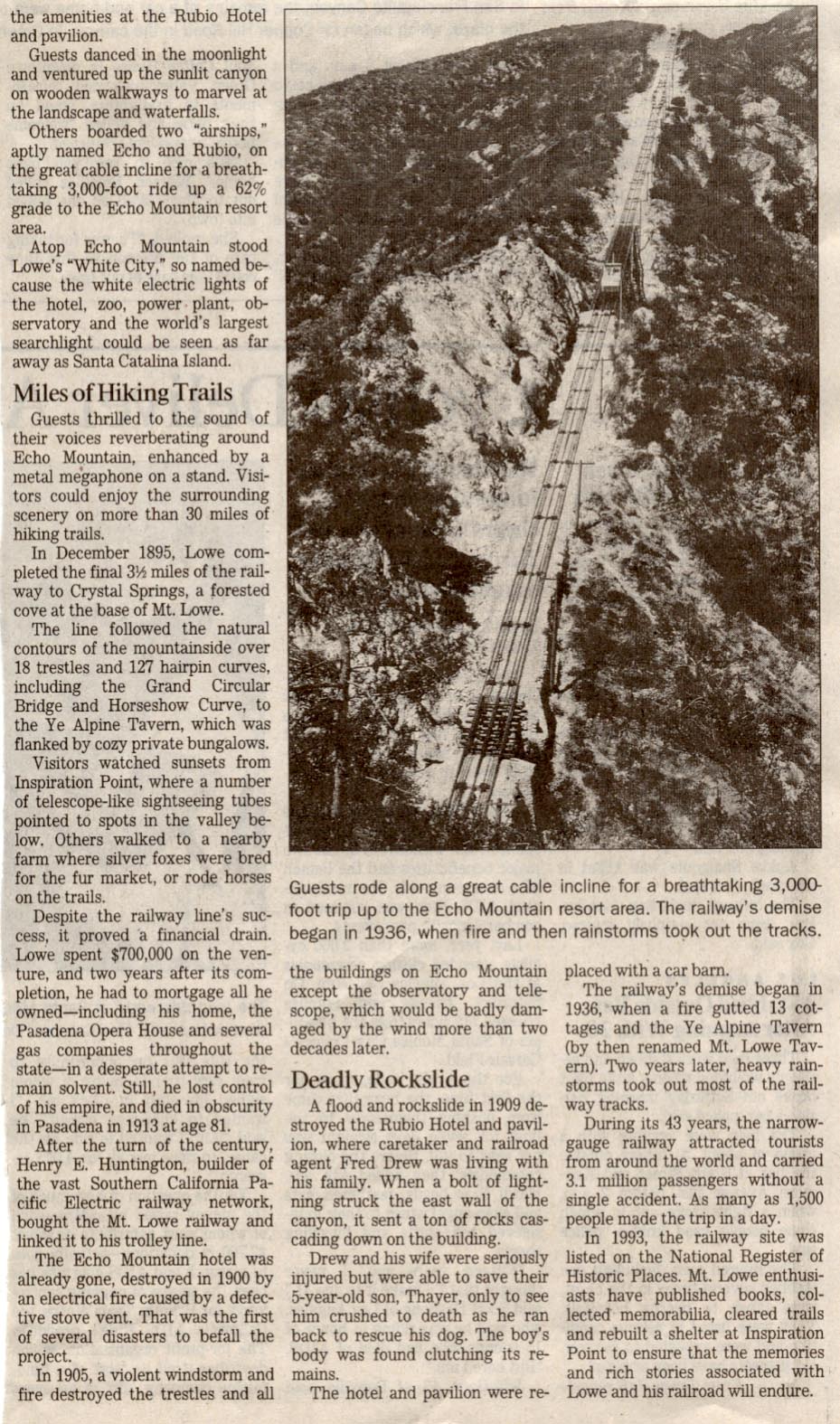
Brief History of Mount Lowe Railway and L.A. Times article
A Brief History of the Famous Mount Lowe Railway
In 1889, David MacPherson, a former Santa Fe Railway civil engineer, planned a steam powered railroad into the mountains behind Pasadena. In 1891, MacPherson and Thaddeus Lowe, a public figure from the Civil War, incorporated the Pasadena and Mt. Wilson Railway. Land near Mt. Wilson was unavailable, so Lowe ran electic trolley cars through Altadena into Rubio Canyon. At the terminus, Lowe built a pavilion transfer station and "The Great Incline". Designed by Andrew Halladie, cable car inventor, the incline was California's first electric cable hoisting mechanism. It traveled 1/2 mile to Echo Mountain summit where Lowe built a powerhouse, Chalet, the Echo Mountain House, a casino (used as a dance pavillion and dormitory), an observatory, residential car barn, gardens, gas holder, zoo and water system. "The White City on the Mountain" was world famous. Echo Mountain House rose 4-stories with a 400 foot wing providing office space, social and recreational halls, a dining room, curio shop, shoeshine stand and 70 rooms. A massive dome crowned the structure. The interior was finished in natural wood.
The Alpine Division began in front of Echo Mountain House. Eleven bridges stretched 1 1/4 miles, then the line continued to the west edge of Echo Mountain. Transversing north, the rail bed was chiseled from the Las Flores Canyon walls and given wooden trestle side washes. At the Cape of Good Hope, the line turned sharply into Millard Canyon. To span the "Grand Canyon of the Millard", MacPherson's huge circular bridge crossed a precipice of 1,000 feet. Blasting through a large granite outcropping, the walls were kept intact so trolley cars could pass through picturesque "Granite Gate." A mile further, a small Swiss-style hotel became the premier hotel on the line. Alpine Tavern offered cozy rooms, a dining room, a parlour warmed by a cavernous fire. Lowe hoped to raise funds to continue the line and build another hotel, but economic and physical disasters ended development at Crystal Spring. Between 1897 and 1901, Lowe lost the railway; ownership; changed several times. Fire destroyed Echo Mountain House on February 5, 1900.
Henry Huntington (Pacific Electric Railway System) bought the railway in 1901. "Red Cars" ran from Los Angeles to Rubio Canyon. Huntington strengthened the bridges and upgraded the track of the Mt. Lowe Line. The casino collapsed during a sever gale on December 9, 1905. The roof flew 60 feet, landing on the powerhouse. Huntington constructed a modern incline mechanism in a new powerhouse. For the Alpine Division, he built open-air crossbench cars and expanded the Alpine Tavern. Amenities included a dining room, billiard room, music room with floor, card room, circulating library and souvenir shop. Recreation included croquet, tennis, riding, hiking an miniature golf. Bungalows surrounded the hotel. A nearby silver fox farm added ambiance. For the next 30 years, the Mt. Lowe Line was Southern California's favorite lodestone. Another windstorm destroyed the observatory in 1928. September 15, 1936, fire completely gutted Alpine Tavern. Although Pacific Electric weighed rebuilding the hotel, the Depression destined the end of the line. On December 5, 1937, the last run carried "The Railroad Boosters" who promoted preservation of the landmark. Bun in March, 1938, heavy rains destroyed the circular bridge and two others. Washed-out track dangled in mid-air. Rails were later salvaged for a WWII scrap drive. The last recognizable ruins of Alpine Tavern were demolished in 1959, and the powerhouse in 1962.

